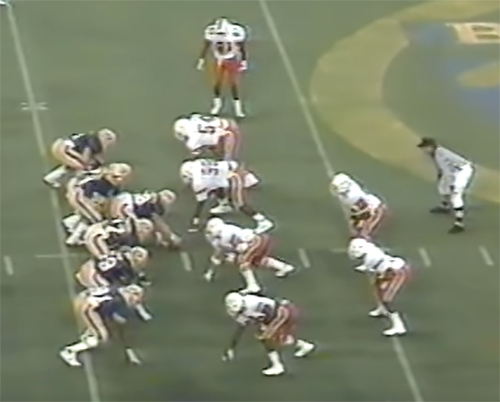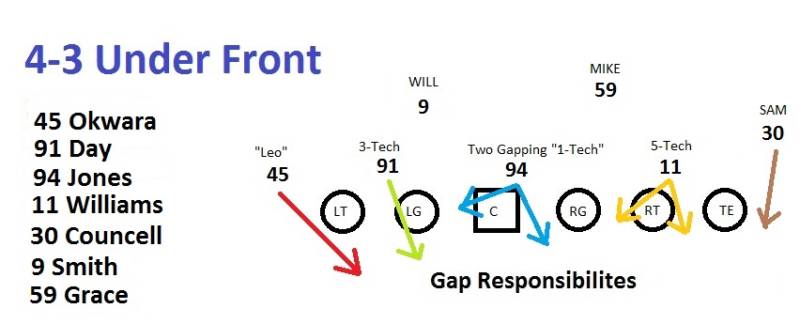Football Defense
With the Playoffs and National Title game between Alabama and Clemson coming up this weekend, I thought it would be pertinent to discuss and cover the primary basics of defense in football. Defenses are vastly varied with different fronts, coverages, and requirements by programs and NFL teams. That’s why there is such an emphasis on scheme fit on the defensive side of the ball as requirements at each position can change simply by what the front is, where the defender is lined up, or what coverage they typically employ.
Defensive Line and Gap Alignments/Techniques
Let’s start with the very basic of defense, the gap alignment. This is usually how the defensive line are lined up opposite the offensive line and tight end. This is worth noting as the Wide 9 Defense has started coming back en vogue in large part thanks to coaches such as Jim Schwartz in the NFL. The numbers are usually represented by even and odd (with the 3-4 primarily relying on even and 4-3 primarily relying on odd alignments).

Credit to Bartlett Defense Part 4 for above image
Coupled with the above are what is called 1 Gap and 2 Gap control, which is exactly what it sounds like. A defensive lineman controlling 1 gap is asked to attack a single gap during the play. They may be asked to attack the right shoulder of the right guard on a run that’s aimed towards the right side and vice versa for a run towards the left side. Due to the responsibilities, a 1 gap scheme tends to be more downhill and attacking the quarterback/running game with little wasted motion. Then you have a 2 gap scheme, which asks the defensive lineman to ascertain what his offensive lineman is doing and where the play is being run to attack the left or right gap. This gap control generally requires mental dexterity and a quick ability to read/react to make the proper diagnosis while lending itself more to stopping the run than attacking the quarterback.
For linebackers and safeties whom are blitzing, you have three gaps between the offensive linemen. The A, B, and C gaps. The A is between the C/OG, the B is between the OG/OT, and the C is between the OT/TE. This is why you will sometimes hear commentators remarking that a linebacker filled the A Gap when stuffing a running back for no gain or a DE stunting (switching) inside through the B Gap for a sack of the quarterback.
Defensive Backfield Coverages
We’ll jump to the coverages as these are primarily the same regardless of the defensive front seven. The most common coverages are Cover 1, Cover 2, Cover 3, and Cover 4/Quarters Coverage. There is also Cover 0 and Cover 6.
Cover 0 is what it says, with 0 safety help deep requiring single man coverage from the cornerbacks on their wide receivers and is primarily done as a heavy blitzing attack on the quarterback. This was a common coverage for Buddy Ryan and his 4-6 Defense during his run as defensive coordinator with the Chicago Bears and head coach of the Philadelphia Eagles.
Cover 1 has a single deep safety to cover the deep middle of the field. The cornerbacks primarily play man coverage on their receivers, usually lined up close to them to try and jam/disrupt their routes, while the outside linebackers are responsible for the tight end and running back. This formation is also a favorite of Alabama’s Nick Saban as he can utilize the outside linebackers as blitzers and have the inside linebacker drop as a “robber” (reading the QBs eyes to disrupt any pass over the middle) or drop all his linebackers into a short zone coverage to defend a quick pass.

Credit to DallasCowboysTimes.com for above image
Cover 2 is usually the most common coverage seen in football. It’s also the most balanced coverage and allows teams to play man coverage, with tight cornerbacks on the receivers, or allow for a zone coverage with the cornerbacks playing off and usually lined up 5-8 yards away from the wide receiver. This coverage formation also allows defensive coordinators to confuse the offense by blitzing linebackers, safeties, or even cornerbacks while then using a zone coverage later and having said players drop back into coverage instead.

Credit to Cardinal Cover 3 for the above image
Cover 3 is a favorite of both Bill Belichick (especially teasing out of an initial Cover 2 look) and Nick Saban at Alabama. The strong safety, lined up towards the tight end side/strong side of the offensive formation, will come down into the box lined up as an extra linebacker to help support the run defense. The free safety will usually “rotate” towards the middle of the field after. The strong safety can also leak out and cover the running back/tight end/slot receiver if they run in the flat area towards the sidelines. The Cover 3 formation primarily relies on zone coverage but much like Cover 1, can allow disguising of a blitz from a linebacker or safety.
Cover 4 or Quarters Coverage is similar to a Cover 2 look, with two deep safeties responsible for the deep field and the cornerbacks playing off coverage but the outside linebackers are in control of manning the flat areas and covering the running backs. If a zone look, which it usually is, the middle/inside linebacker will drop back and cover the middle of the field usually responsible for the slot receiver or tight end.
Cover 6 is, much like Cover 0, exactly what it says. A heavy coverage reliant on zone coverage and dropping all of the linebackers into a zone to support the cornerbacks and two safeties. The strong safety may cheat up and read the release of the tight end or slot receiver. This coverage is most commonly utilized on third downs and long distances, allowing for the quarterback to be forced to throw it short and for the defense to swarm and tackle quickly.
Defensive Fronts and Over/Under Alignment
The most common fronts are the 4-3 and 3-4. But let’s go back in history a little bit here.
In the 1940s and 1950s, Bud Wilkinson popularized the common 5-2 “Oklahoma” defensive front. The Oklahoma defense would utilize even alignment and line up its tackles on the center and offensive tackles much like a modern day 3-4 alignment. Where it differed was that it would line up its two defensive ends (thus the 5 in 5-2) on the two tight ends. Greasy Neale, as head coach of the Philadelphia Eagles is credited with introducing the 5-2 to the NFL while employing an innovative four defensive backs at the time and usually aligning his linebackers up tight to stop the running game.
Into the 1950s, an offshoot came about called the 5-3 defense most associated with Cleveland Browns head coach Paul Brown in which he would utilize a third linebacker instead of a fourth defensive back to help suffocate the run game while allowing for a bigger defender to run sideline to sideline on outside runs. The 5-2 and 5-3 defenses would remain en vogue into the 1960s.
In the 1960s, Tom Landry of the Dallas Cowboys largely introduced the 4-3 to the NFL and more importantly, he tweaked it to the Flex front. The weak side defensive end, lined up away from the tight end side of the formation, was usually a half step back of his offensive tackle, allowing for the Cowboys to portray a variation of a 4-3/5-2 look while defending against the run with the downside being that it exposed the defense to the passing game.
By the 1970s, defensive innovation was still abundant with Hank Bullough, then defensive coordinator of the New England Patriots, and Red Miller, head coach of the Denver Broncos, largely being credited as the inspirations behind the introduction of the 3-4 defense. This allowed for better defense of the short area passing game and was taken up a notch in the 1980s with the New York Giants under Bill Parcells and Bill Belichick thanks to the explosive pass rushing ability of Lawrence Taylor. The Pittsburgh Steelers, Baltimore Ravens, and New England Patriots of the early 2000s are the most commonly known practitioners of the 3-4.
Buddy Ryan introduced the 4-6 defense with the Chicago Bears under head coach Mike Ditka in the mid 1980s. The name is derived from SS Dave Duerson, who made the formation go. If you wanted a defense that would get after the quarterback, this was your defense as it was a reckless abandon against the run game and the quarterback introducing an eight man box. The big key was the strong safety as an in the box safety, essentially serving as a second or third linebacker behind the defensive line while the line itself often employed four defensive linemen and two linebackers serving as potential pass rushers. What made this defense so difficult on opposing offensive coordinators was that it was hard to tell who was coming on a blitz and where they were coming from. Buddy Ryan’s son, Rex Ryan who is the current head coach of the Buffalo Bills, has largely kept up this legacy of seemingly blitzing from all angles and creating havoc.

Along with the NFL came the college football game and the innovation under Jimmy Johnson with the Miami Hurricanes in the 1980s. His big innovation was introducing the 4-3 “Over” defense as seen above. Johnson emphasized the speed and utilized a one gap style to get after the quarterback. The defensive tackle was aligned slightly off the center’s shoulder while the other defensive tackle would be off the shoulder of the right guard. The defensive ends would align themselves off the shoulders of the offensive tackles respectively, in effect forcing the offensive line’s interior to try and figure out whom to double team block whilst accounting for the usually superior speed they were faced with. Jimmy Johnson carried this formation and look to the NFL when he became the head coach of the Dallas Cowboys and Miami Dolphins during the 1990s along with a resurgence in the 4-3 formation itself.

Credit to 4-3 Defense Mixing Gap Responsibilities
The 4-3 “Under” front has become popular in the NFL largely thanks to Pete Carroll during his stint at USC and currently with the Seattle Seahawks. Instead of slightly shading towards the tight end side, the defensive line shifts towards the weak side of the formation with the defensive tackles aligning off the left shoulder of the left guard and right shoulder of the center. The strongside defensive end shifts inside off the right shoulder of the offensive tackle. This allows for an additional blitzer from the right side while strengthening against the running game if the offense decides to try and cut back or run towards the weak side away from the tight end. Multiple NFL teams, including the New England Patriots, have also started experimenting with disguising their defensive lines sometimes lining up in a particular alignment and then shifting to an “Over” or “Under” front at the snap of the football.
TCU’s Gary Patterson and his 4-2-5 defense has been the biggest innovation defensively in the late 1990s and early 2000s. The innovation is Patterson’s utilization of essentially a three Safety system with the weak safety essentially serving as a run stopping in the box safety/fifth cornerback to cover the slot receiver. This style of defense better attacks the modern day spread up-tempo systems while allowing for the four defensive linemen and two linebackers to keep six in the box to support against the running game.
So there you have it, an introduction to the varying basics of defensive gap alignment, defensive coverages, and the evolution of defensive fronts. I hope you learned more leaving than you did entering.
You can check out the rest of my Chalk Dust X’s and O’s series at this link here.

